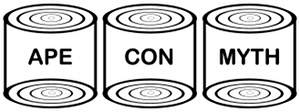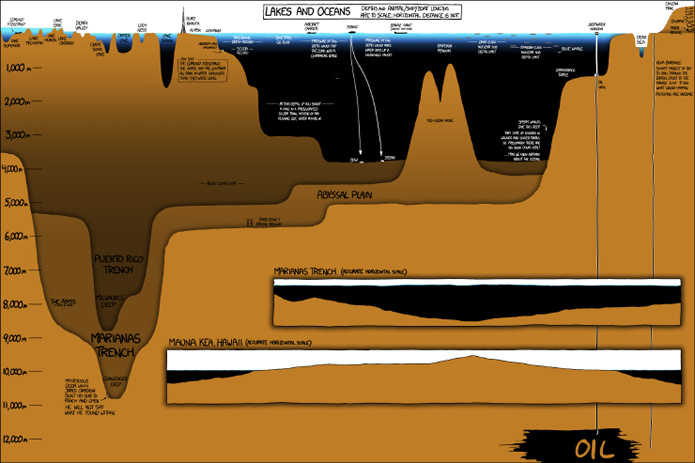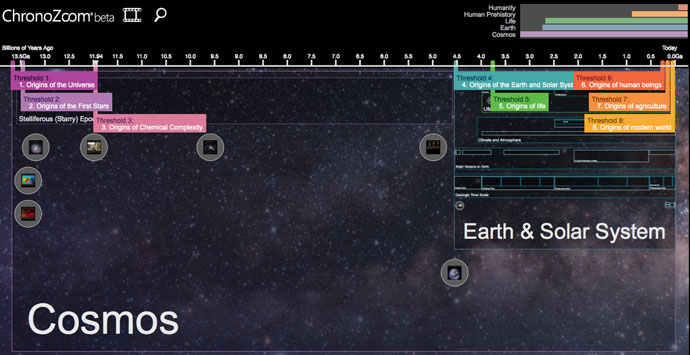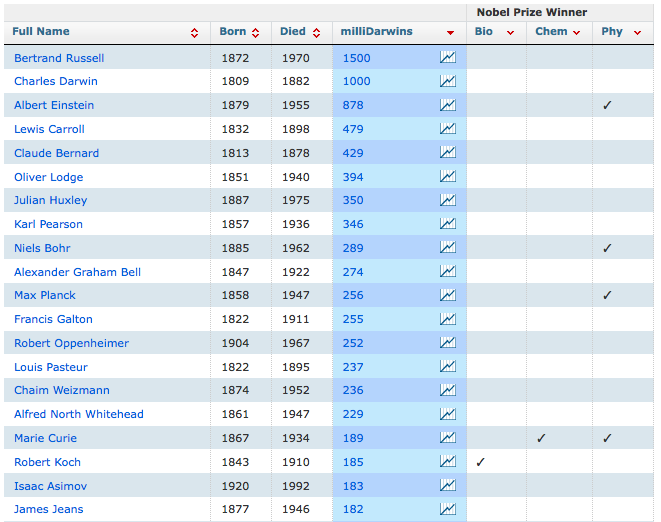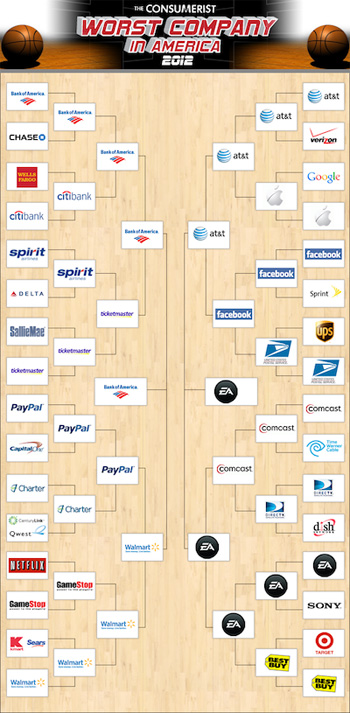If you need a break from filling out your 1040, look no further than xkcd’s /1040/, which happily has nothing to do with taxes despite the timing…
From Big Bangs Come Big Histories
Between the beginning of our universe and the present moment lies 13.5 billions years and so much data that the Information Age hasn’t even put a dent into it yet. Not only did Earth not come together, literally, until 9 billion years after the party started, we, relatively speaking, just showed up a few moments ago. That’s a lot of inside jokes we’ve missed out on, not to mention all the other universes or unknown entities potentially beyond our present understanding.
Despite the disadvantage, the field of Big History was born in the 1980’s with the simple goal of studying history from the beginning of time to the present across multiple disciplines of knowledge. How’s it going so far? Judge for yourself by checking out ChronoZoom, a collaboration between Microsoft Research, UC Berkeley and Moscow State University.
While visually impressive, you might still wonder where you are going to find the time to dive into such a study or why you should even care given that you haven’t filed your taxes yet, but perhaps Bill Gates will one day save up enough money to give us all a couple of days off for such a purpose. Until then, more information can be found at the Big History Project and from David Christian’s TED talk on the subject.
[via Flowing Data] [Related Posts: Carl Sagan’s Cosmic Calendar, Get Your Perspective On]Meanwhile on N1900 Road in Oklahoma
Non-Profit People
Economics Devision
Internal Memo
April 6, 2012
If it’s okay for corporations to be called people, should it follow that people be allowed to seek non-profit status?
Profit-making has such a narrow band of activity associated with it that you couldn’t expect it to cover the entire range of productive human activity. Because whose definition of “productive” are we going to use? Is manufacturing Doritos productive?
There are over 1.5 million non-profits in the United States alone attempting to fill in the blanks and if you accept that artists are doing the same thing in a less tangible way you can add 2 more million to that number, not to mention all the volunteers and caregivers out there.
Too bad it’s the same problem. Non-profits need money too. There’s no way out, even if you’re not really playing the game.
How do we get out?
Famous Scientists for $1,000
Earlier this week we looked at the study of culturomics, which takes the frequency of a word’s use in written literature to quantify cultural trends. Now we’re going to see what can be done with this data on a larger scale, in this case, measuring the impact of scientists.
Here’s the top 20 from the Science Hall of Fame, which includes over 4,000 names from two centuries…
Though the researchers used milliDarwins as the measure of fame for the study, ACM’s favorite, Bertrand Russell tops the list.
To give you a little more perspective on the timelines involved here, check out this video that covers physicists, chemists and biologists and their level of fame by year. You’ll find plenty of new names worth looking into further…
Speaking of, who was Claude Bernard? Turns out he was a french physiologist who worked to bring the scientific method to medicine. First to use the term milieu intérieur (aka homeostatis), let’s close with a quote from him regarding our bodies’ relationship with the external world, which has some interesting relevance to the Ape Con Myth…
The living body, though it has need of the surrounding environment, is nevertheless relatively independent of it. This independence which the organism has of its external environment, derives from the fact that in the living being, the tissues are in fact withdrawn from direct external influences and are protected by a veritable internal environment which is constituted, in particular, by the fluids circulating in the body.
For more on the Science Hall of Fame, you can check out the article from Science explaining their process or go to Gonzo Labs for other materials from the study’s creators, John Bohannon and Adrian Veres.
The Best of the America’s Worst
The voting has ended over at The Consumerist and Electronic Arts has won the title of Worst Company in America for 2012.
Bank of America made it to the final match-up for a second year in a row, but failed to worst EA this year as it did with BP in 2011. The bracket brought together 32 of the least admired companies America has to offer and you can click on the image for the full bracket and blow-by-blow accounts of this year’s battle.
If you’d like to explore the history of the contest, here’s an archive of all the tournaments going back to The Consumerist’s start:
WCIA 2011 – BP beats Bank of America [bracket]
WCIA 2010 – Comcast beats Ticketmaster [bracket]
WCIA 2009 – AIG beats Comcast [bracket]
WCIA 2008 – Countrywide Home Loans beats Comcast [bracket]
WCIA 2007 – RIAA beats Halliburton [bracket]
WCIA 2006 – Halliburton beats ChoicePoint [bracket]
Notice all the repeats. Apparently “worst” doesn’t mean they won’t be around next year. But where else are you going to take your demand when the largest companies control almost all of the supply?
Watch Out For Falling Giants
Economics Devision
Internal Memo
April 3, 2012
Re: Watch Out for Falling Giants
Did anyone notice this line-up in the Econ Devision feed the other day?

That’s quite a few large companies looking vulnerable. Is the age of giants over and if so what might they be willing to do to keep from falling? Whose interest will it be in? How long can the inevitable be put off? Where’s the line between big business and bloated bully? Let’s keep our eyes out for more examples and any past highlights in the field of non-competitive overstaying of welcomes.
File under 00262 – The Behavior of Falling Giants
The Tiny Box Called Today
It’s one thing to live in the present and another to live without a sense of future and past. If there wasn’t so much going on today, that would be clear.
Culturomics attempts to make things clear by analysis of word usage from over five million books going back more than two centuries. Of all the words people have bothered to write down, how do the days of the week rate? That’s just one of many questions you can answer with Google’s Ngram Viewer.
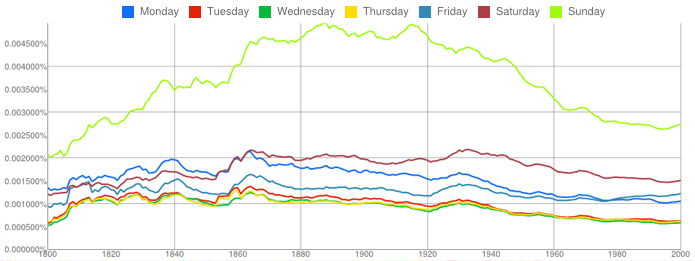
Try ‘ape, con, myth‘ and you find the story of the lowly ape witnessing the slow demise of the con and the rise of the myth.
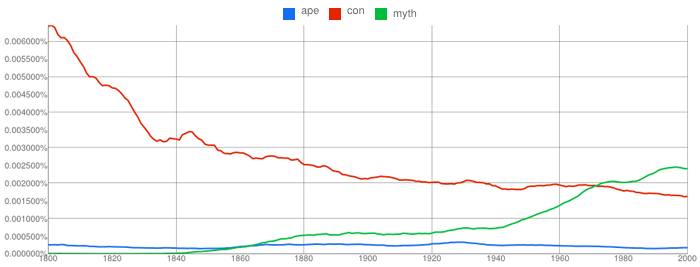
For something more down to Earth, you can found out who is playing second fiddle between ‘peanut butter, jelly’ and ‘beer, wine‘ or check out the historic temporal attitudes of prose writers with ‘yesterday, today, tomorrow‘…
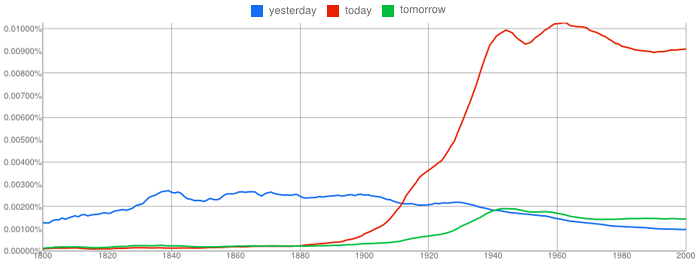
Turns out today wasn’t such a big deal in the 1800’s. … Nor was life expectancy.
If you come up with a good search, please share it in the comments.
